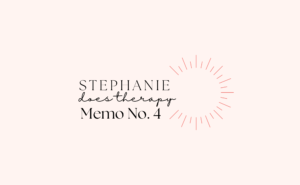Self-doubt wrote a rulebook for my life. One with impossible standards that, suspiciously, no one else seemed to be following. And yet, oddly enough, I wasn’t even holding them to the same standards I held myself to. It made me question every decision, replay every scenario, and add layers of expectations that no one was asking of me. Slowly, it boxed me in. And before I knew it, I wasn’t living — I was just trying not to mess up.
I remember a time when I wasn’t even able to feel present at my best friend’s birthday party. While I was there, I had nothing to say because I was so deep in my own head. Eventually, she pulled me aside and asked if I was okay. I responded, “This is just how I am now. I can’t talk.” And the sad part is, I truly believed that.
I was terrified I was going to lose my friendships — not just that one, but all of them. I spent so much time doubting myself, wondering if anyone was actually interested in what I had to say. I believed I’d lost my ability to be funny, relatable, or engaging, and I decided it was safer to just stay quiet or not show up at all. But the truth was, it wasn’t safer — it was hurting me, and it was hurting my relationships.
That was self-doubt at work. It didn’t just rob me of confidence — it robbed me of connection, presence, and experiences I can’t get back.
When we start pulling back the layers, self-doubt isn’t just a sign of low self-esteem or a personality quirk. It can come from different places. For me, it was a blend of both trauma and untreated obsessive-compulsive disorder (OCD). Some of my mental rules were rooted in trauma responses — ways my mind learned to stay “safe.” Others were classic OCD patterns like intrusive thoughts, relentless what-ifs, and compulsive mental checking.
If this sounds familiar, you might wonder — what’s the difference between trauma-driven doubt and OCD-driven doubt? Trauma often teaches us that we must be vigilant or careful to stay safe, so we learn to doubt ourselves as a form of protection. OCD, on the other hand, fuels self-doubt with intrusive, looping thoughts that don’t feel like a choice. Both can create strict internal rules that feel impossible to live up to — and yet we keep trying.
But I didn’t know any of that at the time. I just thought I was the problem. I thought I was indecisive, too sensitive, and too “in my head.” Therapy helped me name it. Treatment gave me tools. But what helped me the most was this:
Doing it anyway.
Whatever “it” was — saying no to something I didn’t want to do, making time for myself even when others weren’t happy about it, or speaking up for myself even when it was uncomfortable — I stopped waiting for perfect conditions, absolute certainty, or complete confidence. I started calling it organized chaos. I’d pick a direction, decide the first step or two, and then let the rest unfold — imperfectly, messily, but with intention. I let go of the control I thought I needed to prevent failure or disappointment. I quit buying into the idea that doubt was just a low self-esteem issue.
And I learned something important: even if I followed all the rules, unexpected things would still happen. Life was never meant to be fully controlled. It was meant to be lived — mess and all.
But here’s the truth: doing it anyway sounds simple, but living it is much harder.
In our minds, we know it’s the right thing to do. But in reality? It feels big. It feels scary. We don’t want to disappoint anyone. We don’t want to come across as demanding, difficult, or selfish.
If you’re reading this and thinking, “Okay, but where do I even start?” — here’s something that helped me: pay attention to where you hesitate. What are the decisions or moments where you feel stuck, unsure, or like you need someone else’s approval? That’s usually where self-doubt is the loudest.
And that’s exactly where doing it anyway begins. It doesn’t have to be a grand, sweeping act. It might just be sending the text, saying no, resting without apologizing, or showing up even if you feel awkward. Over time, these small choices build the confidence that self-doubt was trying to convince you wasn’t possible.
If you’re ready to feel more confident and grounded in your self-esteem, it’s time to find your power in doing it anyway. You don’t have to figure it out alone. Schedule a consultation with me here and let’s see if we’re a good fit.

